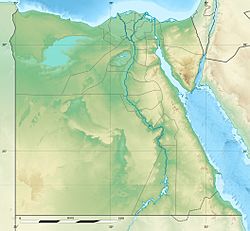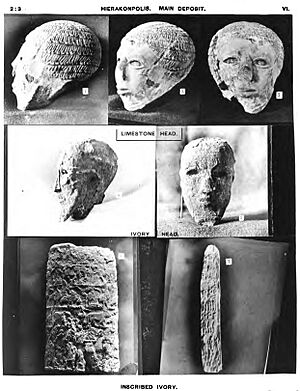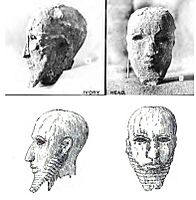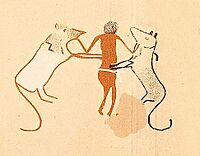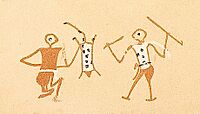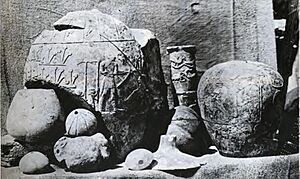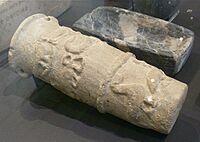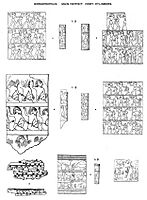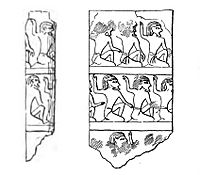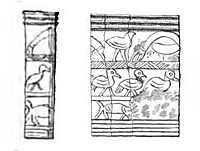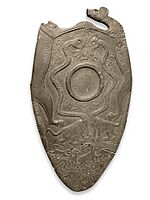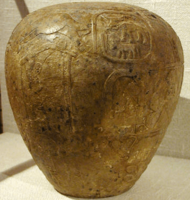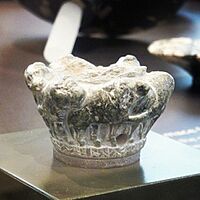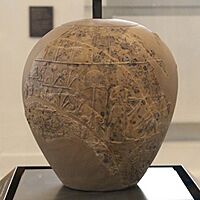Nekhen facts for kids
| Alternative name | Hierakonpolis (Greek) |
|---|---|
| Location | Aswan Governorate, Egypt |
| Coordinates | 25°5′50″N 32°46′46″E / 25.09722°N 32.77944°E |
| History | |
| Material | Possibly, oldest painted Ancient Egyptian tomb |

Nekhen (also called Hierakonpolis) was a very important city in ancient Egypt. It was the main religious and political center for Upper Egypt. This was at the end of Egypt's prehistoric time (around 3200–3100 BC). It was also likely important during the Early Dynastic Period (around 3100–2686 BC).
Nekhen is home to the oldest known tomb with painted walls. This amazing artwork on plaster walls dates back to about 3500–3200 BC. It shows pictures similar to those found in the Gerzeh culture.
Contents
Nekhen: A Center for the Falcon God Horus
Nekhen was the main place for worshipping a hawk god named Horus of Nekhen. People built one of the oldest Egyptian temples here for him. Even after the city became less important, it stayed a special place for worshipping this god, who was a protector of kings.
The first people settled in Nekhen around 4400 BC, during the Amratian culture. Some think it might have been even earlier, around 5000 BC, during the Badari culture. At its busiest, around 3400 BC, Nekhen had at least 5,000 people. It might have even had as many as 10,000.
Later, most of Upper Egypt came under the control of rulers from Abydos. This happened during the Naqada III period (3200–3000 BCE). This meant that rival cities like Nekhen became less powerful. Some ancient pictures, like those on the Gebel el-Arak Knife or in Tomb 100 at Nekhen, might show these conflicts.
Discovering Ancient Nekhen
The ruins of Nekhen were first dug up by English archaeologists James Quibell and Frederick W. Green. This happened in the late 1800s.
The Main Deposit Discovery
In 1894, Quibell and Green found something special called the "Main Deposit." It was a collection of items buried under the temple. Quibell was trained by Flinders Petrie, who is known as the father of modern Egyptology. However, Quibell did not always follow Petrie's careful methods.
The temple site was hard to dig up, and the records of what was found were not very clear. For example, the famous Narmer Palette was thought to be in the Main Deposit. But later reports showed it was found a little distance away.

The items in the Main Deposit were placed there during the early Old Kingdom. But their artistic style shows they were made much earlier, during the Naqada III period. This means they were moved into the deposit later.
Another important item found was the Scorpion Macehead. It shows a king, known as Scorpion II, taking part in a ceremony to water fields. The Narmer Palette is more famous because it shows the first king wearing the crowns of both Upper and Lower Egypt. But the Scorpion Macehead also hints at early fights with the north. It shows dead lapwings, which was a symbol of Lower Egypt.
More Excavations at Nekhen
John Garstang also dug at Nekhen in 1905–06. He first wanted to explore the town itself. But he had trouble and focused on an area he thought was a 'fort'. This site was built by King Khasekhemwy of the Second Dynasty.
Underneath this area, Garstang found a cemetery from before the dynasties. It had 188 graves. These graves belonged to ordinary people living in Nekhen during that time. They showed how non-royal Egyptians were buried.
More recently, a team of experts from different countries has been digging at Nekhen. This team was led by Michael A. Hoffman, then by Barbara Adams, and now by Renée Friedman.
Mysterious Stone Structures
The large mud-brick building at Nekhen, often called a "fort," was built by King Khasekhemwy of the Second Dynasty. It looks similar to other structures at Abydos that were also called 'forts'. But these buildings probably weren't used for fighting. Their real purpose is still a mystery. They seem to be connected to royal ceremonies and ancient Egyptian beliefs about kingship. In ancient Egypt, religion and kingship were very closely linked.
This building at Nekhen was built on top of an old cemetery. Digging there and later, people taking bricks from the walls, have damaged the structure. In 2005 and 2006, the team led by Friedman worked to make the building stable again. They used new mudbricks to support the damaged parts.
In 1998, during digs at Hierakonpolis, archaeologists found evidence of ritual masks. These masks were similar to those used in places further south of Egypt. They also found a lot of obsidian, a type of volcanic glass, which came from quarries in Ethiopia.
The Oldest Painted Tomb in Egypt
Another amazing discovery at Nekhen is Tomb 100. It is the oldest known tomb with a mural painted on its plaster walls. This tomb is believed to be from the Gerzeh culture (around 3500–3200 BC).
The paintings in the tomb likely show religious scenes. They include figures that were important in Egyptian culture for thousands of years. You can see a funeral parade of barques (boats), a goddess standing between two lionesses, and a circle of horned animals. There are also staffs linked to ancient cattle worship. Animals shown include onagers (wild donkeys) or zebras, ibexes (wild goats), ostriches, lionesses, impalas, gazelles, and cattle.
Some people think the pictures in the Nekhen tomb are similar to those on a special knife found in Egypt, called the Gebel el-Arak Knife (around 3500–3200 BCE). This knife has scenes that look like they came from Mesopotamia, showing a figure with two lions, fighting scenes, or boats.
The World's Oldest Zoo
In 2009, archaeologists digging at Nekhen found the oldest known collection of zoo animals. This "menagerie" dates back to about 3500 BC. The animals found included a leopard, two crocodiles, hippos, hartebeest, two elephants, baboons, and African wildcats. The bones of these animals, found in a cemetery, showed signs of being broken. This suggests they were kept in captivity.
Nekhen's Long History
Nekhen continued to be used for a very long time. Later tombs from the Middle Kingdom, Second Intermediate Period, and New Kingdom have been found there. For example, in the painted tomb of Horemkhauef, an inscription tells about his journey to the capital city. He lived during the Second Intermediate Period.
Because Nekhen was so important to Egyptian ideas about kingship, the temple of Horus there was used for thousands of years. It remained a religious center even into the Ptolemaic Kingdom, which was much later.
Amazing Artifacts from Nekhen
Cylinder Seals
Cylinder seals found at Nekhen show some of the first pictures of an ancient Egyptian king hitting captured enemies with a mace. These seals are thought to have been inspired by similar items from Mesopotamia.
Cosmetic Palettes
Many beautiful decorated palettes from before the dynasties were found in Nekhen. They show animals inspired by Mesopotamian art, like serpopards (creatures with snake-like necks and leopard bodies). They also have some of the earliest hieroglyphs.
-
The Narmer Palette from Nekhen, showing serpopards.
Maceheads



